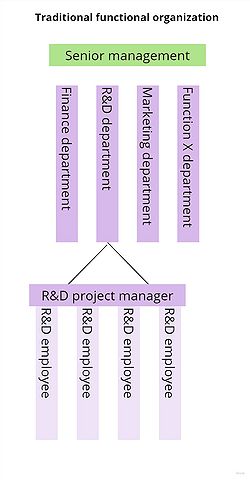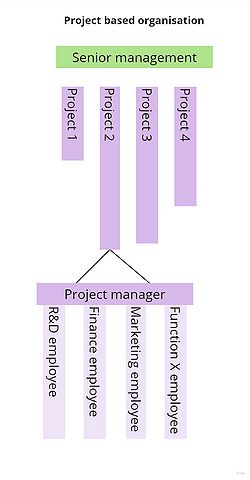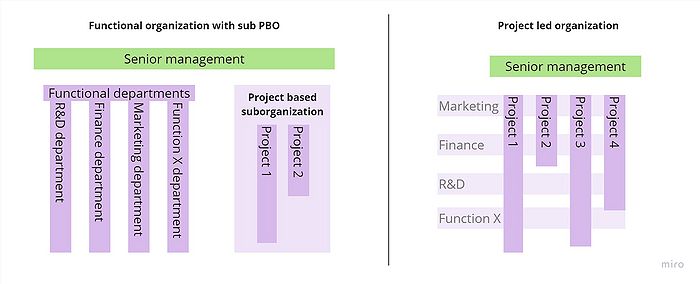Project based organisations
Summary
This article presents the theory of project based organizations (PBO's). The Project Based Organization is an organizational structure that supports project driven businesses. The functional organization is presented as a comparison to the PBO in order to better understand the problems it solves. The PBO is a structure which is organized according to projects instead of functional units. This gives the project manager high authority and responsibility for the success of projects, making project, program and portfolio management highly important to practice competently. The advantages of the PBO are that they are work well in complex and dynamic environments with high uncertainty and risk. Additionally the PBO is advantageous when working across multiple organizations or with external clients. The article proceeds to present a suggestion for strategies to implement an PBO structure, suggesting to start on experimental one team basis. Then the main limitations within PBO's are presented. The key limitations are lack of knowledge sharing and organizational learning across multiple projects, as well as coherence throughout the organization and to senior management, creating problems with effectiveness and support. Lastly the article presents the limitations of application of the PBO structure. The main limitation when applying the theory of PBO's is that it requires a restructuring of an organization, which is a huge task. Furthermore, the theory behind the PBO that one needs to build the application upon, is complex and goes across several research domains. It is therefore a resource heavy theory to apply in practice.
Contents |
Introduction
In recent years more industries are moving towards project based approaches [1]. The traditional way of organizing development is rigid in its structures leading to problems in execution of new and innovative initiatives. This is because the organizational structures inhibits the flexibility necessary to develop in a dynamic environments, and inhibits the flexible nature of projects [2]. This has lead researchers and practitioners to looking at ways of organizing in a more flexible manner; projects. The film industry is a classic example of an industry that has historically been working project based [1] [3] [4]. This way of working has reached increased attention in other industries in the last couple of decades, where Michael Hobday's work on Project based organisations[5] has been a key source of inspiration for many researchers to build on [3] [6] [7][8][9][10].
This article will give an overview of Project Based Organizations (PBO's). The article will first present the big idea; the characteristics of PBO's, how they solve the problems that occur in the traditional organizational structures. It will present and an overview of the PBO comparing it to the traditional functional organization structures as well as give perspectives on how Project, Program and Portfolio management relates to the PBO. It will present an application of the PBO; what strategies exist for transforming organizations and which steps to take to enhance the specific values that a PBO structure brings. Lastly the article will present the limitations of PBO's, both giving an overview of the limitations inherent to the PBO, as well as limitations in application.
Big Idea
What are Project based organizations?
The Project Based Organization is an organizational form that attempts to create a system that favors the dynamic and flexible environment of projects.[2] [4] To better be able to understand the PBO an introduction of its opposite; the traditional functional organization, is necessary.
The functional organization
The traditional functional organization, is an organizational form which is structured in functional units (departments) each specialized within a certain domain. Classical examples of departments are; R&D, Finance, Marketing etc.. [11] The structure of the functional organization is illustrated in figure 1, where it can be seen that the departments all run parallel to each other with no links in between. Each department refers to the Senior management, who are in charge of creating the objectives of the organizations' vision and strategy. [2] [11] The head of each department thus have to make sure that initiatives within their own department align with the strategy and vision to keep the support of Senior Management.[12] This is often done through structured documenting practices and well defined formal procedures, such as reporting.


The parallel running departments in the functional organization creates silo systems, that makes this type of organization well suited for repetitive operations with small incremental changes. However the structure becomes problematic if the organization introduces a high rate of projects.[4] This is because there is little range for flexibility or cross domain collaboration in such silo structures. In a functional organization, a project and therefore project manager (PM) would be underneath a head of department in the organizational hierarchy. The role of the PM is therefore often mostly coordination and only little decision making, as this lies with the head of departments. If a project needs collaboration across departments, the manager would thus have to refer to, and ask permission from all department managers before making decisions. This creates high control for the head of departments yet low control for the project manager. This leads to problems in project progress due to low flexibility and authority, with the project manager. It leads to poor communication internally in the project team and with external partners, because the PM can rarely answer urgent questions immediately as they have to ask for permission from each department manager. This leads to frustration for the PM and lack of confidence in the PM with the project team and client. For the above mentioned reasons it becomes difficult to execute innovative and experimenting initiatives, with high uncertainty and risk, as well as projects that need competences across specializations in a functional organization. [2] [4]
The Project based organization, attempts to solve these issues of cross collaboration and flexibility. [13] [4]
The project based organization
The Project Based organization attempts to create a structure that favors the dynamic and flexible environment of projects. The Project Based Organization (PBO) is an organizational structure where[4][2][13];
- projects are the main driver of business
- the project manager has high control over functions and resources
- the flexibility inherent to the structure enhances the ability to be proactive towards uncertainty and risk
- organizational openness enhances collaboration with external partners making it easier to be proactive toward e.g. client uncertainty
These 4 characteristics will be elaborated further below.
1. Project based organizations are driven by projects.[4] Figure 2, illustrates how projects run parallel to each other and are the main driver of the business instead of the specializations that lie in the departments as seen in the functional organization. The functional units, i.e. R&D, finance, marketing etc. are integrated in each project in the PBO by gathering a team of employees with different specializations. Furthermore, when working project based contrary to function based the knowledge and capabilities are created and build throughout the project. [14] This means that project based organizations requires that the employees not only know their specializations but also have the competences to acquire new knowledge and capabilities [9]. However, employees will only have the project to work on, and therefore do not have to prioritize between operational and project work. This frees up time and mental space for building these capabilities. [2]
2. The project manager is the main responsible for execution and decision-making in the projects that run in the organization. This means they have high control over all functions of the projects including resources, with only senior management to refer to, as seen in figure 2.[2] Because of the integration of specializations the project manager does not have to try to build collaboration across rigid departments as seen in the functional organization. Instead the PM is given high authority over the project. One of the mechanisms behind this is that the controlled step of referring to the department heads is eliminated. The simple link from PM to senior management is the key to agility and flexibility that is inherent to PBO's. [7]
3. Due the above described structures and the authority that lies with the PM, the PBO has the ability to deal with fast change as well as being proactive to uncertainty and project risk. The project manager, has the power to make the necessary decisions to urgent problem, and have a better standpoint for negotiations. [13] [7] This characteristic of the PBO stands in contrast to the functional organization where the project manager would not have the authority to make proactive decisions. [2]
4. One of the ways of dealing with complexity is stakeholder engagement.[15] The authority of the PM is an advantage when working with external partners and working across several organizations, because it leads to an organizational openness.[13] This is because the point of contact is reduced to just the PM, instead of the PM and a number of other departments cf. characteristic described above. [2] This organizational openness makes it easier to include external stakeholders and bring them close to the project process. [13] The enhancement of communication this brings leads to a PM that can ensure that external partners are properly informed, and even part of decision-making processes throughout the project, often leading to higher satisfaction with the client. Thus the PBO becomes an enabler for co-creation in projects. PBO's are therefore beneficial when dealing with complex project where the clients' needs may change through the progression of the project as they gain more knowledge. [2]
The PBO in theory and practice
According to the PMBOK Guide 2021 a project is " [...]a temporary endeavor undertaken to create a unique product, service, or result."[16] The definition refers to uniqueness, and even though not all standards agree on this factor, it can still be concluded that projects are often different and need different types of structures to support them and to get the best results. [17] Thus, because PBO's are driven by projects the organization can look very different both from organization to organization, but also from project to project within the PBO.
Project to project variance in the PBO
The PBO creates temporary organizations each time a new project is initiated. This means that the objectives of the project will partly define the organizational structure within that project. For example; the level of complexity or innovation of the project will have an impact on; the size of the project, the amount of stakeholders involved, the uncertainty of the project etc. These are all factors that will influence the temporary organization that is created when initiating a project.
Another factor that will influence the project is the contractor or client of the given project. These will often have different needs and requirements for the project and its collaboration or partnership structures, thus shaping the communication structures of the project. This is exactly the benefit of PBO; they are so flexible that they can adapt to the given context of the project; they can adapt to the best possible way of operating with the specific client, project team, project content, project complexity etc.
Organizational context of the PBO
The PBO can as mentioned also look different from organization to organization. The "pureness" of the PBO can be altered, to fit the organizational needs. In some industries it is possible to create more or less pure PBO's. The classic example is as mentioned the film industry. [1] [3] However, a PBO can also exist within a functional organization as a sub organization as shown in figure 3. [13] [4] Lastly, the PBO can exist as a so called Project Led Organisation. This is the most common form of the PBO in practice. It has weakly linked functional units that run across the projects, helping to create coherence between the individual project in the organization, but keeping the main decision authority with the PM.[3] [2] [13]This structure is shown in figure 3.
 Figure 3: Left; The PBO as a suborganization in a functional organization. Right; Project Led Organization (Created by J. Steinfurth)
Figure 3: Left; The PBO as a suborganization in a functional organization. Right; Project Led Organization (Created by J. Steinfurth)
Summing up, the PBO is a project driven business and therefore changes with its environment. It is capable of doing so because of its flexibility and the authority that lies with the PM, creating an open organizational structure and a proactive approach towards uncertainty and risk. The authority that lies with the PM is thus a positive characteristic of the PBO. However, with the authority follows a responsibility. Therefore good management, and especially good Project, Program and Portfolio management, is of vital importance for success in such organizations.
Project, program and portfolio management theory in the PBO domain
The following paragraph will help give an overview of the relationship between the PBO and Project, program and portfolio management (PPPM).
PBO's operate in two distinct levels of activities; the organizational level and the project level. [9] [18] These levels are represented in figure 4; The strategy and business models are developed on the organizational level (green), and the activities at Project, Program and Portfolio levels should support that strategy (purple). [19] This relationship between the organizational level and project level is further described in the PMI standard, where strategy implementation is one of the main activities of portfolio management and where defining program outputs that support organizational strategy is one of the main activities of program management. [20]
In the context of the PBO, the project manager becomes the link and enabler of the strategies developed on organizational level, to integrate them on project, program and portfolio level. This is illustrated as the arrows in figure 4. Researchers suggest that the PBO framework even enhances the effectiveness of project portfolio management, because of the authority of the PM. [7] Cite error: Closing </ref> missing for <ref> tag [2] [5] [10] [7] [6] [21] [9] [3] [8] [17] [12] [20] [16] [11] [14] [15] [18] [22] [23] [24] [25] [4] [13] [19] [26] [27] [28] [29] [30] [31]
Cite error:
<ref> tags exist, but no <references/> tag was found